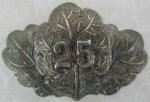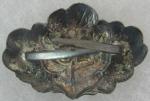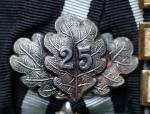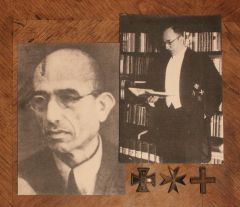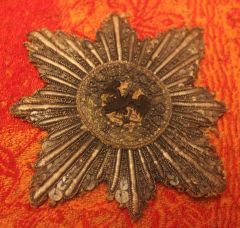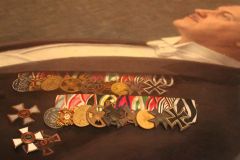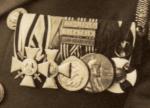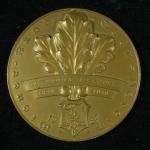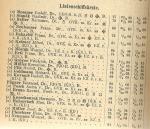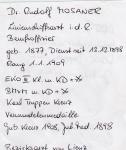-
Posts
1,291 -
Joined
-
Last visited
-
Days Won
20
Content Type
Profiles
Forums
Blogs
Gallery
Events
Store
Everything posted by Komtur
-
Many thanks for your input, Trevor and sorry for the late reply. I will try to make myself clear, what I am aim for. There are lots of different types of Oak Leaves for the 2nd class of the Iron Cross 1870 on the marked. Often there is the question, is this or that version an original and old made one or not. This is difficult to answer, because the Oak Leaves had to be provided privately and were not delivered by officials, e.g. the General-Ordenskommission. In my opinion there is a way to answer by compiling versions of Oak Leaves on order bars and evaluate this statistically. There is a danger indeed, that also on an order bar is a modern fake. But ist is less likely, that on two, three or even ten different order bars the same version is to be found as a copy. Until now I examined 44 bars with some interesting results. Therefore please, showed ORDER BARS with an Iron Cross 1870 with OAK LEAVES in this thread. Later I will give a summary of the results here in the GMIC. Thanks and Regards, Komtur.
-

The pride of a Jewish German (4)
Komtur commented on Komtur's gallery image in Category 3: Medals & Awards
Of all the four persons I presented pictures of their decorations here, I could found lots of biografical informations. Dr. Wollenberg from Berlin and Dr. A. G. from Hamburg survided the war and continued to stay and work in their hometown in Germany. I work on an article for the magazin of German Medal Society (Deutsche Gesellschaft für Ordenskunde) about their lifes in detail. -
For a compilation of different types I am searching for oak leafs of the Iron Cross 2nd class 1870. To make it more probable, that these are made originally, I am specially looking for oak leafs on order bars. The result is to be found here. Later I will give a summary in the GMIC too. Therefore please show in this thread high resolution pictures of oak leafs on order bars. Thanks! Regards, Komtur.
-
Schrader 1824 Wilkens v. Hohenau 1824 Pfeiffer 1836 Dr. Bäumler 1839 v. Starck 1836 Wachs 1853 Cramer 29.10.1856 Frh. v. Dörnberg 25.10.1856 (Johanniterorden 1854) v. Schmerfeld 1860 Sezekorn 1860 Unfortunately the early Prussian Ordenslisten did non mention the day and month. These complete Ordenslisten with all living decorated persons were edited between all 6 to 10 years. In between were published annual so called "Veränderungen" (= Changes) with the complete date. I got only some of these "Veränderungen" and do not know, if these came out regularly. Regards, Komtur.
-
-
-
-
-
-
-
-
The difference to the here dicussed Crown Orders is, that these are mostly very scarce items (as Trevor wrote e.g. 1st classes with Red Eagle Order ribbon between the arms or with swords or swords on the ring or both!). There was no or only a hand full of recepients still living after 1918. Therefore in this case we see a significant disproportion of circulating items on today marked and the need of privately by wearers bought orders. They overflowed the collector marked always offered as originals in the 1970ies via one auction house and one dealer. Besides this they are marked W for Wagner, but have a significant different design (as Trevor desribed) to awarded Crown Orders. In my opinion because of these reasons the only clear description can be: FAKE. Regards, Komtur.
-
The Prussian orders were awarded only to officers or to similar ranking civil persons. The Allgemeine Ehrenzeichen (General Honour Decoration) were instituted for lower military or civil ranks. To have a possibility for more differentiation in honoring persons of the lower social classes the Allgemeine Ehrenzeichen in Gold (General Honour Decoration in Gold) were created in 1890. Because of economical reasons these massive golden medals were replaced in 1900 by the Kreuz des Allgemeinen Ehrenzeichen (Cross of General Honour Decoartion). In 1912 the decorations ranking below the orders were supplemented by the Verdienstkreuz in Gold (Honour Cross in Gold), Verdienstkreuz in Silber (Honour Cross in Silver) and Allgemeines Ehrenzeichen in Bronze (General Honour Decoration in Bronze). At the end of the monarchy there were the following non order lower decorations (from highest to lowest): 1. Verdienstkreuz in Gold 2. Verdienstkreuz in Silber 3. Kreuz des Allgemeinen Ehrenzeichens (former medal Allgemeines Ehrenzeichen in Gold) 4. Allgemeines Ehrenzeichen in Silber 5. Allgemeines Ehrenzeichen in Bronze To make it more complicated there was the possibility to award the three crosses (1.-3.) with the Royal Crown or to award the Royal Crown to these crosses. That is roughly the developement of the decoration system below the orders after 1839. In the early 19th century there were some other regulations and changes. Regards, Komtur.
-
Indeed. The different ribbons for the Prussian Orders (Red Eagle Order, Crown Order, House Order of Hohenzollern) were defined in 1864 on the occasian of the war with Denmark. The black ribbon with white stripes, also known as Combattant Ribbon, can be traced back to the Iron Cross ribbon from 1813 and goes primarily with the sword decorations of the three orders above. This regulation was only for natives, foreigners received sword decorations on the statute ribbon, what we can see especially for Austrians, Turks and Bulgarians in WW1. Because of the creation of sword decorations in 1848, some years before the ribbon regulations in 1864, we find awards "mit Schwertern" of the Red Eagle Order on the statute (white ribbon with red stripes) before 1864 also for Prussian natives. These persons were allowed in 1864, to change their ribbons to the black and white combattant version. More complicated are the regulations for the white ribbon with black stripes, also created in 1864 for the main three Prussian Orders. The tradition of this kind of ribbon goes also back to the 1813 Iron Cross, in this case of its noncombattant ribbon. It is related to services in the context of wars, but for not directly fighting persons. Therefore we find this ribbon mostly awarded to military officials ("Militärbeamte"). If these persons were in direct contact to the fight or front ("im feindlichen Feuer"), they received decorations with swords on the white/black ribbon, if they were not, without swords on the white/black ribbon. Decorations on non statuary ribbons are rare. In the period form 1848 to1918 were about 112.000 awards of the Red Eagle Order 4th class. In the same period we find about 3.200 awards of this class of the Red Eagle Order with swords and (from 1864 on) with the black/white ribbon. More scarce are awards with the white/black ribbon - in the same space of time there were about 560, half with and half without swords. Higher classes of the Red Eagle Order with the white/black ribbon are rarities with low single- or double-figure award numbers. These numbers are similarly for the Prussian Crown Order. Some exceptions are mentioned by Dave. Regards, Komtur.
-
This group was discussed here before, but I could not find the thread. As I remember there were some doubts about it. Could this person please be checked by the new source Glenn found, the KuK 1918 Jahrbuch für Militärärzte? Thanks, Komtur.



